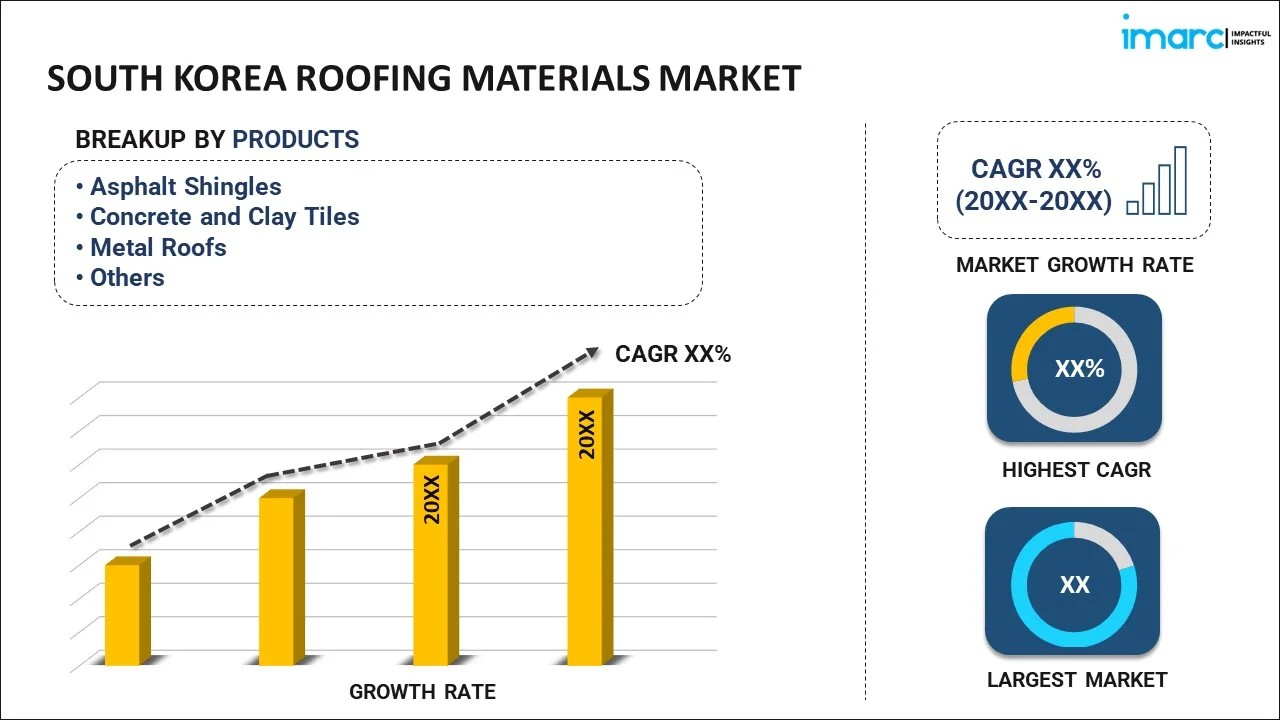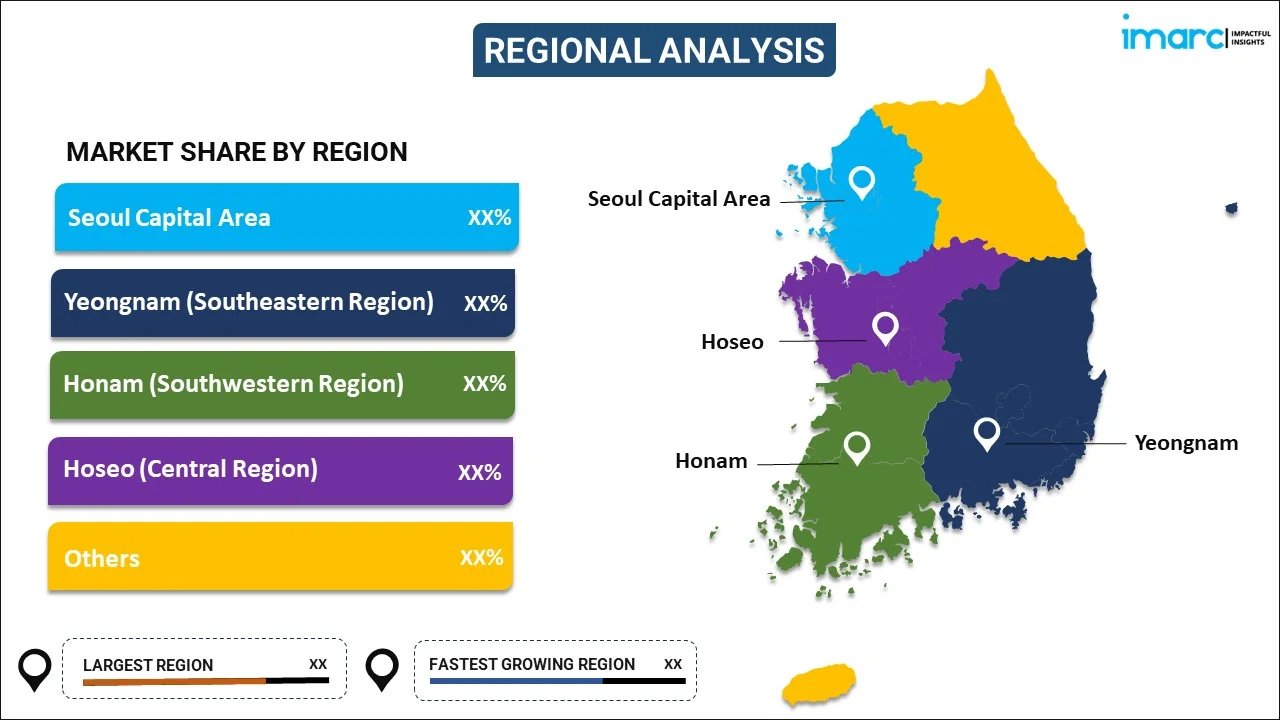
South Korea Roofing Materials Market Report by Product (Asphalt Shingles, Concrete and Clay Tiles, Metal Roofs, Plastics, and Others), Construction Type (New Construction, Reroofing), Application (Residential, Non-Residential), and Region 2025-2033
Market Overview:
South Korea roofing materials market size reached USD 2.7 Billion in 2024. Looking forward, IMARC Group expects the market to reach USD 3.6 Billion by 2033, exhibiting a growth rate (CAGR) of 3.1% during 2025-2033. The rapid population growth and urbanization, which contribute to increased construction activities, leading to a higher demand for roofing materials in both residential and commercial sectors, is driving the market.
|
Report Attribute
|
Key Statistics
|
|---|---|
|
Base Year
|
2024 |
|
Forecast Years
|
2025-2033
|
|
Historical Years
|
2019-2024
|
| Market Size in 2024 | USD 2.7 Billion |
| Market Forecast in 2033 | USD 3.6 Billion |
| Market Growth Rate (2025-2033) | 3.1% |
Roofing materials play a crucial role in protecting homes and buildings from the elements while also contributing to their aesthetic appeal. Various materials are employed in roofing, each with its own set of characteristics and advantages. Traditional options like asphalt shingles are popular for their cost-effectiveness, ease of installation, and durability. Metal roofing, known for its longevity and resilience against harsh weather conditions, has gained popularity as a sustainable and energy-efficient choice. Tile and slate roofs offer a timeless and elegant appearance, often associated with upscale homes. Modern innovations include synthetic materials that mimic the look of traditional options while providing enhanced durability and weather resistance. Additionally, green or eco-friendly roofing materials, such as living roofs with vegetation, contribute to energy efficiency and environmental sustainability. The choice of roofing material depends on factors like climate, budget, and aesthetic preferences, making it a crucial decision in the construction or renovation process.
South Korea Roofing Materials Market Trends:
The roofing materials market in South Korea is experiencing robust growth, primarily driven by an increasing regional emphasis on sustainable construction practices. Consequently, the rising demand for eco-friendly roofing solutions has propelled the adoption of materials such as solar reflective and cool roofs. Additionally, the escalating frequency and intensity of extreme weather events attributed to climate change have underscored the importance of resilient roofing materials. Furthermore, the construction industry's recovery from the economic downturn has fueled a surge in new building projects, boosting the demand for a variety of roofing materials. In tandem, advancements in technology have led to the development of innovative materials with enhanced durability, energy efficiency, and aesthetic appeal, further influencing market dynamics. Moreover, government initiatives promoting energy-efficient construction and renewable energy integration have incentivized the use of advanced roofing materials, contributing to the market's upward trajectory. In conclusion, a confluence of factors, including sustainability goals, climate considerations, economic recovery, technological advancements, and supportive policies, are driving the flourishing roofing materials market in South Korea during the forecast period.
South Korea Roofing Materials Market Segmentation:
IMARC Group provides an analysis of the key trends in each segment of the market, along with forecasts at the country level for 2025-2033. Our report has categorized the market based on product, construction type, and application.
Product Insights:

- Asphalt Shingles
- Concrete and Clay Tiles
- Metal Roofs
- Plastics
- Others
The report has provided a detailed breakup and analysis of the market based on the product. This includes asphalt shingles, concrete and clay tiles, metal roofs, plastics, and others.
Construction Type Insights:
- New Construction
- Reroofing
A detailed breakup and analysis of the market based on the construction type have also been provided in the report. This includes new construction and reroofing.
Application Insights:
- Residential
- Non-Residential
The report has provided a detailed breakup and analysis of the market based on the application. This includes residential and non-residential.
Regional Insights:

- Seoul Capital Area
- Yeongnam (Southeastern Region)
- Honam (Southwestern Region)
- Hoseo (Central Region)
- Others
The report has also provided a comprehensive analysis of all the major regional markets, which include Seoul Capital Area, Yeongnam (Southeastern Region), Honam (Southwestern Region), Hoseo (Central Region), and Others.
Competitive Landscape:
The market research report has also provided a comprehensive analysis of the competitive landscape in the market. Competitive analysis such as market structure, key player positioning, top winning strategies, competitive dashboard, and company evaluation quadrant has been covered in the report. Also, detailed profiles of all major companies have been provided.
South Korea Roofing Materials Market Report Coverage:
| Report Features | Details |
|---|---|
| Base Year of the Analysis | 2024 |
| Historical Period | 2019-2024 |
| Forecast Period | 2025-2033 |
| Units | Billion USD |
| Scope of the Report | Exploration of Historical and Forecast Trends, Industry Catalysts and Challenges, Segment-Wise Historical and Predictive Market Assessment:
|
| Products Covered | Asphalt Shingles, Concrete and Clay Tiles, Metal Roofs, Plastics, Others |
| Construction Types Covered | New Construction, Reroofing |
| Applications Covered | Residential, Non-Residential |
| Regions Covered | Seoul Capital Area, Yeongnam (Southeastern Region), Honam (Southwestern Region), Hoseo (Central Region), Others |
| Customization Scope | 10% Free Customization |
| Post-Sale Analyst Support | 10-12 Weeks |
| Delivery Format | PDF and Excel through Email (We can also provide the editable version of the report in PPT/Word format on special request) |
Key Questions Answered in This Report:
- How has the South Korea roofing materials market performed so far and how will it perform in the coming years?
- What has been the impact of COVID-19 on the South Korea roofing materials market?
- What is the breakup of the South Korea roofing materials market on the basis of product?
- What is the breakup of the South Korea roofing materials market on the basis of construction type?
- What is the breakup of the South Korea roofing materials market on the basis of application?
- What are the various stages in the value chain of the South Korea roofing materials market?
- What are the key driving factors and challenges in the South Korea roofing materials?
- What is the structure of the South Korea roofing materials market and who are the key players?
- What is the degree of competition in the South Korea roofing materials market?
Key Benefits for Stakeholders:
- IMARC’s industry report offers a comprehensive quantitative analysis of various market segments, historical and current market trends, market forecasts, and dynamics of the South Korea roofing materials market from 2019-2033.
- The research report provides the latest information on the market drivers, challenges, and opportunities in the South Korea roofing materials market.
- Porter's five forces analysis assist stakeholders in assessing the impact of new entrants, competitive rivalry, supplier power, buyer power, and the threat of substitution. It helps stakeholders to analyze the level of competition within the South Korea roofing materials industry and its attractiveness.
- Competitive landscape allows stakeholders to understand their competitive environment and provides an insight into the current positions of key players in the market.
Need more help?
- Speak to our experienced analysts for insights on the current market scenarios.
- Include additional segments and countries to customize the report as per your requirement.
- Gain an unparalleled competitive advantage in your domain by understanding how to utilize the report and positively impacting your operations and revenue.
- For further assistance, please connect with our analysts.
 Request Customization
Request Customization
 Speak to an Analyst
Speak to an Analyst
 Request Brochure
Request Brochure
 Inquire Before Buying
Inquire Before Buying




.webp)




.webp)












